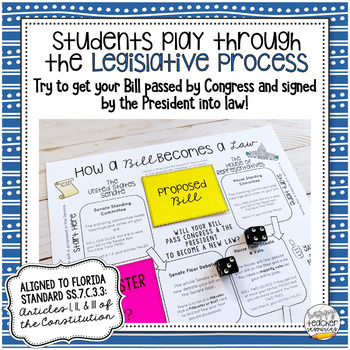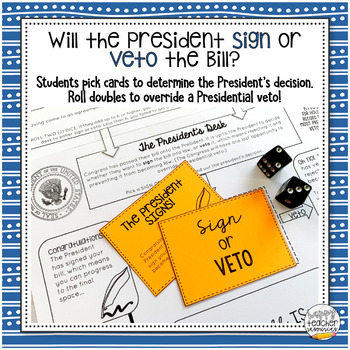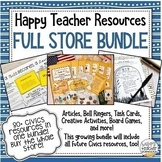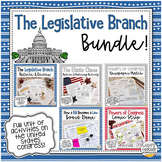How A Bill Becomes A Law Game | Legislative Branch Activity for Civics!
- PDF
What educators are saying
Also included in
- This Full Store Civics Bundle includes everything Civics-related in the Happy Teacher Resources TPT store. With over 80 products so far, this bundle offers a wide-range of resources covering so much of your Civics curriculum: everything from articles to board games, station activities to escape roomPrice $250.00Original Price $372.75Save $122.75
- This Legislative Branch Activities Bundle is the perfect resource for your Civics or American History unit on the powers of Congress and the Legislative Branch! Reading passages and a matching activity introduce the powers and responsibilities of the United States Congress, including the tricky ElasPrice $18.00Original Price $22.50Save $4.50
Description
This How a Bill Becomes a Law Board Game takes your students through the Legislative Branch's lawmaking process, from proposing a bill on the floor of Congress, through floor votes, filibusters, and conference committees, all the way to the President’s desk. The more the students play, the more they memorize the steps of the legislative process — all while having a blast! If you're studying the Legislative Branch in your middle or high school Civics, American Government, or American History class, this game will provide hands-on enrichment, practice, and a whole lot of fun!
Aligned to the Florida State Standard SS.7.CG.3.3: Articles I, II, & III of the Constitution, this board game takes students through the lawmaking process step-by-step. In this game, students will:
✯ Select a Proposed Bill Card they will try to get through Congress and onto the President's desk.
Proposed Bills include:
- You are a Senator from Florida proposing 500 million dollars in federal funding to build solar panels and convert Florida to clean solar energy.
- You are a Senator from California proposing to raise the minimum wage to $15 an hour to keep up with inflation and the high cost of living.
- You are a Representative from California who wants to propose a tax relief for any American that buys an electric or energy-efficient car this year.
✯ Determine whether their bill begins in the House or Senate and, by rolling dice, try to get through the standing committees and onto the chamber floor for a vote.
✯ Try not to get Filibustered! If their bill makes it to the Senate floor for a vote, students will have to select a "Filibuster or Not?" card to see whether a fellow Senator tried to stop their vote from happening. Roll an even number to invoke cloture and break the filibuster!
✯ Make it through the Conference Committee and onto the President's Desk! Once their bill has made it onto the President's desk, students pick a Sign or Veto card to find out the President's decision. If their bill gets rejected, they have one more chance to override the presidential veto -- otherwise, their bill is dead!
Students can play either in pairs or in small groups, with two teams of 2-3 players to each gameboard. Students play all the way down the board on their turn, until their bill either becomes a law or gets rejected. I like to have students play for 15-20 minutes, and tell them that whoever collects the most successful bills by the end of time wins! The more they play the game, the more they begin to memorize the legislative process -- without even realizing it!
This resource includes:
✯ 3-page Gameboard, with illustrations, instructions on each game space, and fun factoids sprinkled throughout!
✯ 3 sets of cards: 18 Proposed Bill cards, 9 Filibuster or Not? cards, and 9 Sign or Veto cards.
✯ Prep and Gameplay teacher instructions
✯ How to Play Instruction cards to be given to each group
✯ A page of Bill Scrolls that can be printed out and used as gameplay tokens
✯ A Reflection worksheet to be filled out after the game!
The reflection includes such questions as:
- How many of your bills failed? At what point in the process did they fail?
- What percentage of bills become law in a typical Congress session?
- Define filibuster, conference committee, and veto
- Why do you think it is necessary to make it difficult for a bill to become a law?
This is a really fun, hands-on game that turns surprisingly addictive! If you'd like to give your kids a real taste of the lawmaking process -- both its frustrations and its triumphs -- give this game a try!
This resource is presented as a non-editable PDF.
If you enjoy this resource, leave a review! Go to “My Purchases” on your TPT account, scroll to the resource, and click the green “Provide Feedback” link. You can rate the product, leave a review, and collect TPT credits that you can use on other products!
Other Happy Teacher Products You Might Like:
✩ Legislative Branch Article & Review for Civics & American History!
✩ Powers of Congress Newspaper Matching Activity | Legislative Branch for Civics
✩ Powers of Congress: The Elastic Clause Article & Matching for Civics
✩ Enumerated Powers of Congress Comic | One-Pager for Civics & American History
Follow Happy Teacher Resources so you're the first to find out about new products!
You can also follow my social media: Instagram | Pinterest | Facebook







